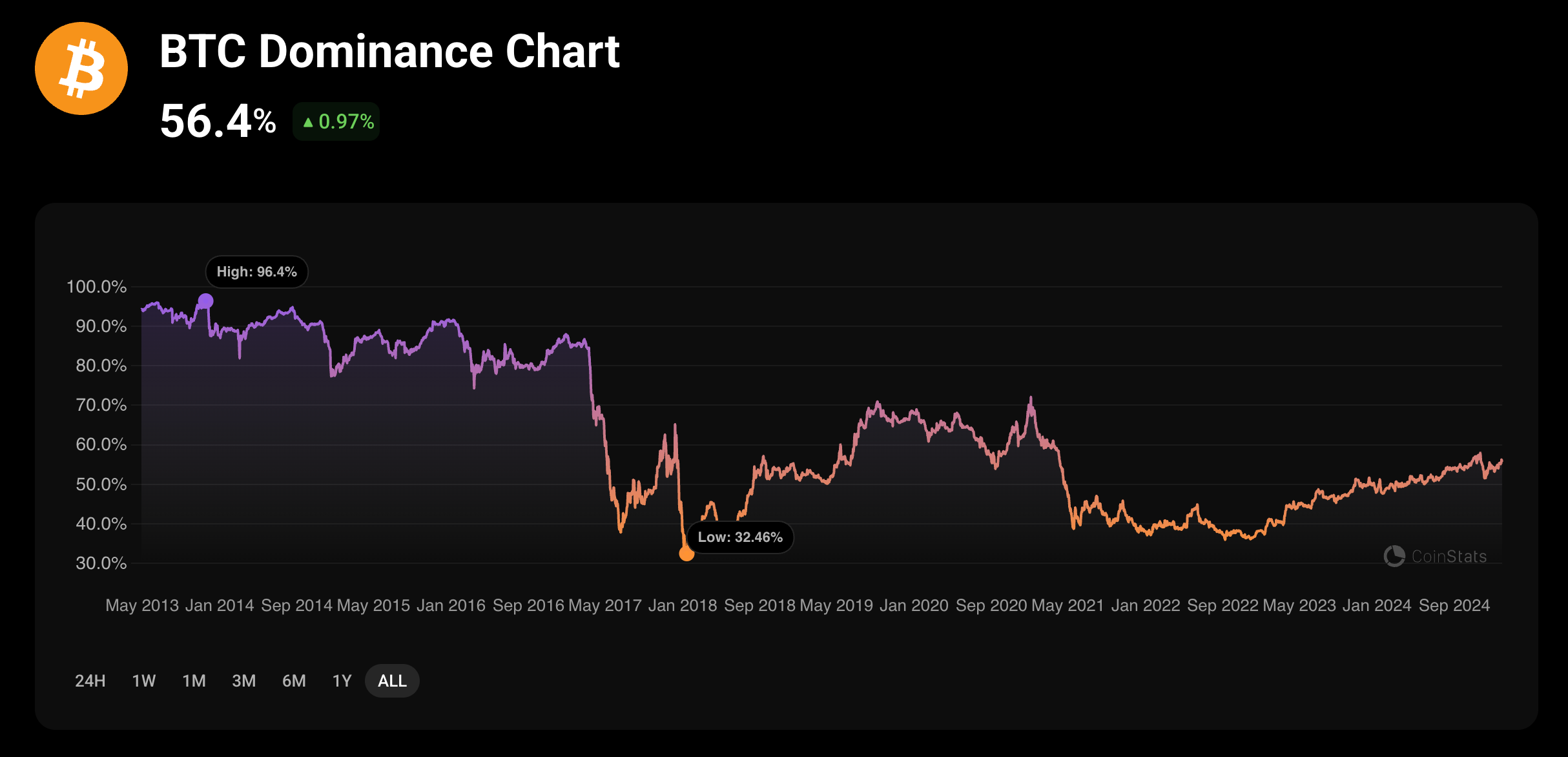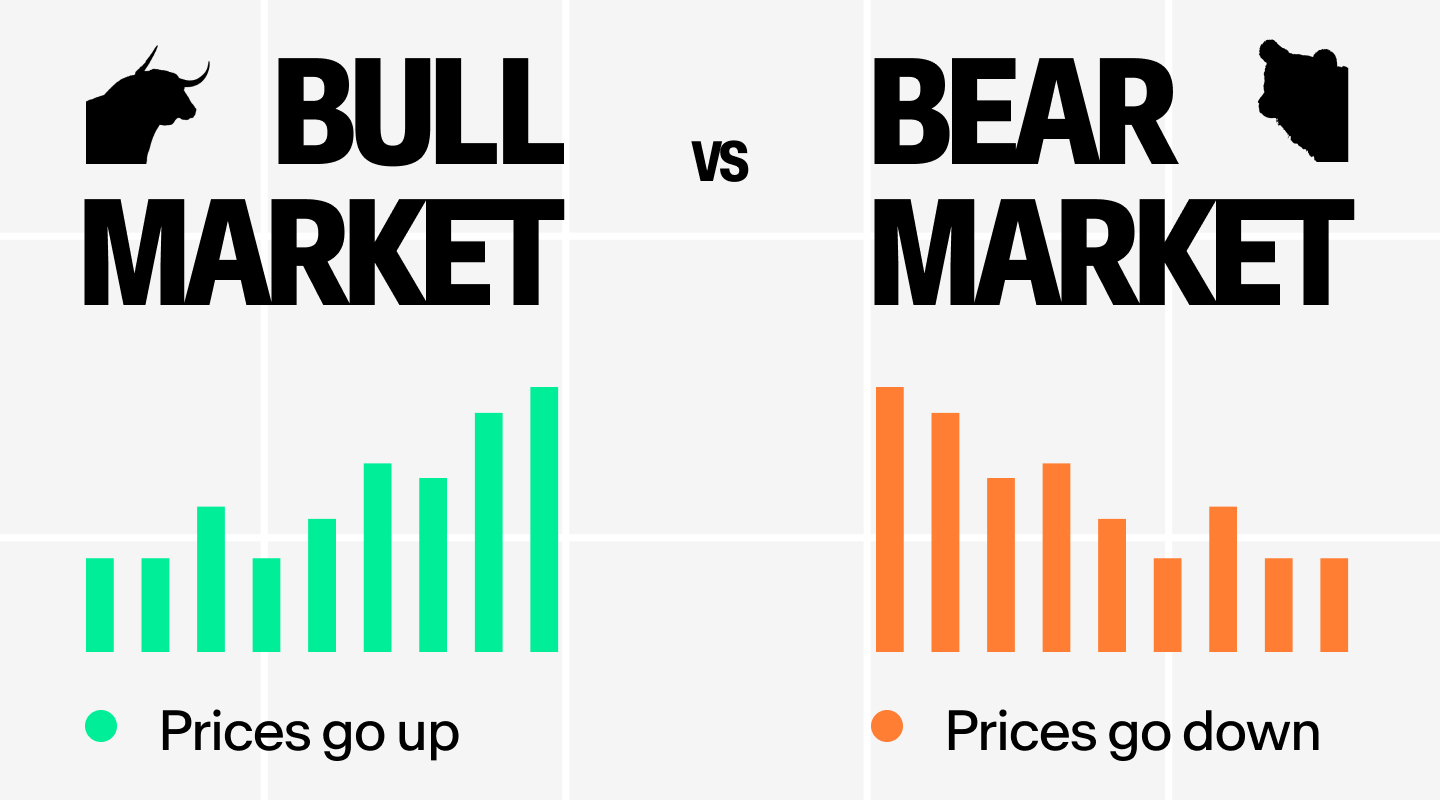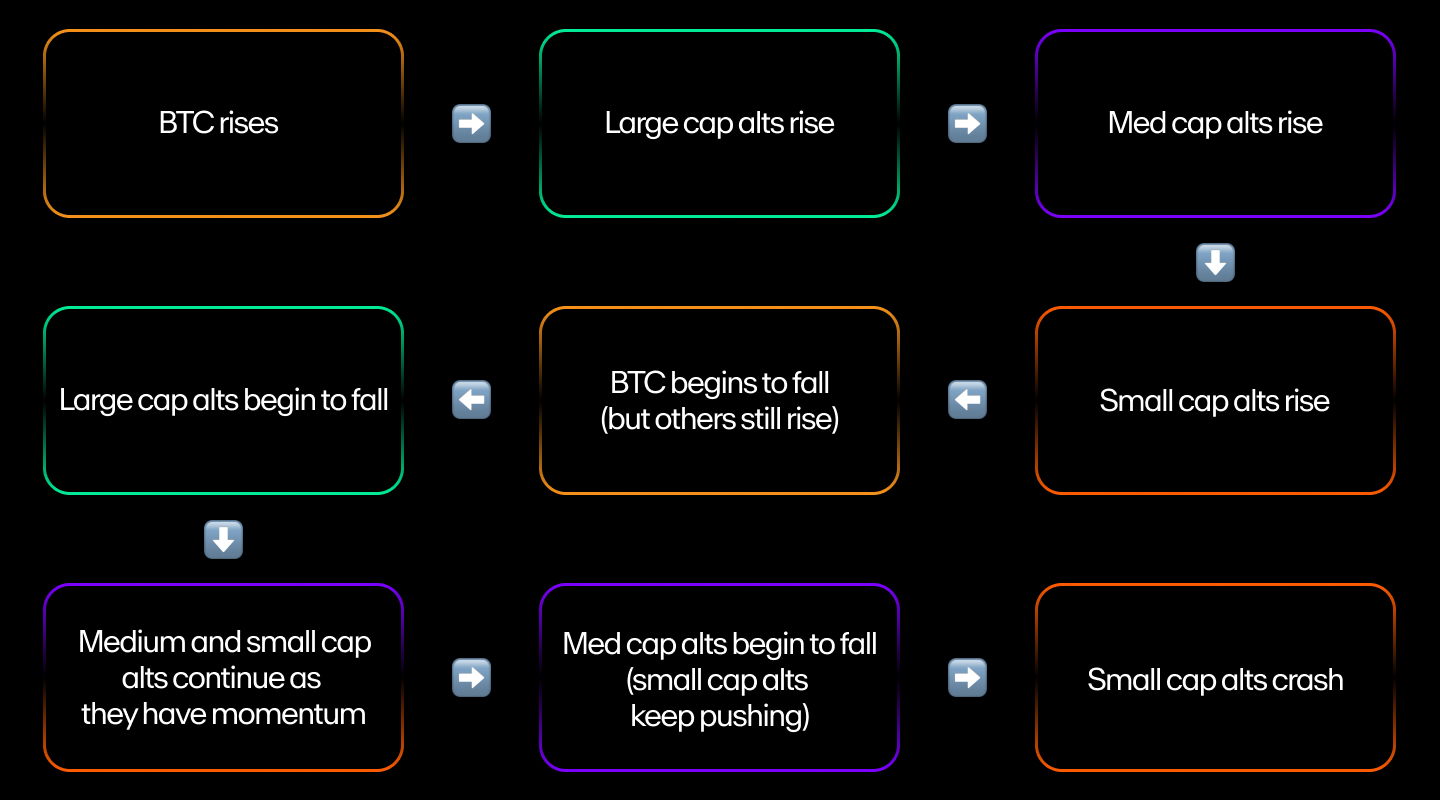Bitcoin is the first digital and decentralized cryptocurrency, and remains one of the most reputable cryptocurrencies in the world.
Given its huge market capitalization, which often exceeds all of the largest altcoins combined, it's no exaggeration to say Bitcoin exerts a massive influence on the entire crypto market. You could even say BTC dominates the cryptocurrency marketplace.
As such, when discussing the market caps of Bitcoin and other cryptocurrency tokens, a common term that comes up is Bitcoin Dominance. But what is this important metric and how is it used?
This article explains what Bitcoin dominance is, how it works, and how you can use it to better understand market trends.
What is Bitcoin Dominance?
Bitcoin Dominance is the ratio between the market capitalization of Bitcoin to the total market cap of the entire cryptocurrency market. This important metric gives a sense of Bitcoin's value relative to other cryptocurrencies, and is often used by investors and traders to try to help make better crypto investment decisions.

Historically, the direction of the overall crypto market cap has followed Bitcoin's market cap. This is primarily due to Bitcoin's position as the leading cryptocurrency in the crypto market, preferred by users and financial institutions alike.
Since Bitcoin often dictates the rest of the marketplace, BTC dominance becomes a necessary metric to measure its impact at any time. But how is it measured?
How to calculate Bitcoin dominance
You can arrive at the Bitcoin dominance index by simply dividing Bitcoin's market cap by the total market capitalization of all other cryptocurrencies:
Bitcoin dominance = Market cap of BTC / Market cap of all other cryptocurrencies
As an easy exercise, let's assume that the Bitcoin market cap is $5 trillion and the total crypto market cap is $10 trillion. In this case, by using the formula (5 trillion / 10 trillion), Bitcoin's dominance is 50%.
Real Bitcoin Dominance
Some traders use a variant of Bitcoin dominance called the Real Bitcoin Dominance Index, which only takes into account coins that rely on the Proof of Work consensus mechanism.

The rationale for this approach is that Real Bitcoin Dominance Index is committed to tracking the movement of coins that have the potential to be used as a decentralized means of exchange in the future.
How to calculate Real Bitcoin Dominance
The Real Bitcoin Dominance Index is calculated by dividing Bitcoin's market capitalization by the market cap of Bitcoin and other PoW cryptocurrencies:
Real Bitcoin Dominance Index = Bitcoin Market cap / (Market cap of BTC + Market cap of other PoW cryptocurrencies)
A point of distinction between Real Bitcoin Dominance and Bitcoin dominance is that Real Bitcoin Dominance excludes ICOs and stablecoins, given their association with centralized intermediaries.
Throughout 2024, the Real Bitcoin Dominance Index fluctuated between 71% and 76%, down from its recent years' high of 85%, which occurred in December 2019. So far in 2025, 71%-72% has been the general range for Real Bitcoin Dominance.
History of Bitcoin dominance
In 2017, the ICO boom and emergence of numerous altcoins (cryptocurrencies other than Bitcoin) led investors to start using BTC dominance to determine if alternative currencies were experiencing an upswing or a downturn relative to Bitcoin's price.
While the index started to be used in trading communities around 2017, it actually didn't become popular until the altcoin boom of 2021. CoinMarketCap and TradingView arose as some of the early platforms to monitor Bitcoin dominance, providing helpful charts and tools to popularize it as a way to observe market sentiment and trends.

- Until 2017, Bitcoin accounted for as much as 95% of the total crypto market cap, given the previous lack of serious competition from other cryptocurrencies.
- Back in early 2018, due to the ICO boom and the rising popularity of other blockchains like and Solana, BTC dominance fell to an all-time low of 37.6%.
- In 2019, when Ethereum suffered a price crash of 87%, BTC dominance surged back up to around 71%.
- Throughout 2024, Bitcoin dominance varied between 52% and 61%, peaking in November of last year.
- Today, in 2025, BTC dominance has ranged between approximately 56% and 60%.
How is Bitcoin dominance correlated with market capitalization?
As seen above, Bitcoin dominance uses market capitalization as a primary factor to measure Bitcoin's market share. But how do you calculate market cap itself?
Market capitalization is the total value of the cryptocurrency, i.e., the total number of coins that have been mined multiplied by the price of a single coin:
Market capitalization = Total number of coins mined x Price of a single coin
The market cap of any cryptocurrency indicates how popular it is among investors. It is used by investors to get a holistic picture of the currency's position and market share relative to other coins in the crypto market.

Similar to traditional stocks, cryptocurrencies can be grouped by their relative market caps.
- Large-cap cryptocurrencies are those with a market cap of ~$10 billion or more.
- Mid-cap cryptocurrencies are more volatile but might also offer more growth potential.
- Small-cap cryptocurrencies may have a lot of potential for short-term growth, but are frequently quite volatile and are generally seen as a more risky crypto investment.
If you're wondering which category Bitcoin qualifies under, we can use an easy exercise:
In December 2024, the the price of a single Bitcoin hit $100,000 for the first time, when the circulating supply of BTC was around 19.791 million.
By multiplying the two, we arrive at Bitcoin's market cap in that month: over $1.97 trillion.
Why is Bitcoin the most popular cryptocurrency for investors?
Bitcoin has emerged as the “gateway cryptocurrency” and is usually the first investment that crypto traders make before acquiring other cryptocurrencies. This is due to a few reasons:
- BTC has high visibility as the most popular cryptocurrency
- BTC is available on nearly every crypto exchange, as well as brokerage services via Spot Bitcoin ETFs.
- BTC's supply is deflationary due to its halving mechanism
As market demand rises and investors move to acquire cryptocurrency, Bitcoin's price rises and usually most other cryptocurrencies will follow Bitcoin’s lead. There has therefore usually been a positive correlation between BTC and the overall market cap of the crypto market.
What factors influence BTC dominance?
While there are several factors that influence market conditions and BTC dominance, some are more significant than others.
Changing market trends
Over the years, with the growth of altcoins, BTC has lost a significant portion of its market share. This is because chains like Ethereum boast programmable smart contracts and can host decentralized applications (dApps).
While dApps (and NFTs) be deployed on the Bitcoin network, especially after updates like SegWit and Taproot, there are still bottlenecks to be addressed since the chain is not built from the ground up to tackle these hurdles.
Usually, when Bitcoin dominance rises, it means that people are investing more in Bitcoin compared to altcoins like Ethereum and Solana. This means one of two things: either BTC is rising faster than altcoins or it's falling slower.
Bull markets and bear market
A general rule of Bitcoin dominance is quite simple: altcoins rise hard and fall harder.
In a bull market, altcoin popularity rises. This can cause investors to turn to altcoins, NFT projects, and riskier assets in the hope of seeing big returns. This will cause BTC dominance to fall.

In bear markets, on the other hand, BTC dominance usually rises because investors may turn to cryptocurrencies that have stood the test of time.
On-ramping via stablecoins
The rise of stablecoins—cryptocurrencies whose price attempts to maintain a stable value by being pegged to a stable asset like the US dollar—has put prolonged pressure on BTC dominance. In particular, during a bear market or other periods of volatility, stablecoins are frequently utilized as a cryptocurrency perceived to be less volatile than many others.
Stablecoins may be used by more risk-averse investors when market conditions are volatile. This allows crypto-native investors to stay within the cryptocurrency ecosystem during periods of extreme market volatility.
Stablecoins currently have a market valuation of roughly $134 billion. Tether, the largest stablecoin, has a market cap of about $110 billion, up from $4.1 billion at the start of 2020. The market value of the second largest stablecoin, USD Coin, is about $33 billion.
As a result of stablecoin on-ramping, the share of the entire crypto market valuation attributed to Bitcoin has been diluted and is shrinking. With the fall of USTC in 2022, however, this trend is not necessarily guaranteed to continue.
New coins and projects
At present, there are thousands of cryptocurrencies in existence, with a total market cap of over $3 trillion. NFT collections such as VeeFriends and CryptoPunks have also emerged as alternative crypto assets, which could be favorable for altcoins given that most NFTs are on these non-Bitcoin blockchains, such as Ethereum and Solana.
How to use Bitcoin dominance
Understanding Bitcoin's market share can be a useful tool for evaluating the health of the overall cryptocurrency market. Below are a few ways to use this metric:
Consideration in managing risk
Investors can use BTC dominance as one factor to help try to manage their overall risk exposure to the cryptocurrency market.
For example, if the value of BTC is decreasing but Bitcoin dominance is increasing, that could be an indication of a potential bear market for altcoins. In that case, investors who are heavily invested in altcoins may consider selling some of their positions and moving into Bitcoin.
Investors might use BTC dominance as a barometer to help them gauge the overall market sentiment and make decisions about how they should diversify their crypto portfolio.
If you're looking for another way to manage your exposure to cryptocurrency prices over time, consider crypto recurring buys. By buying a little bit at regular intervals, you can limit the effects of price swings on your portfolio through dollar-cost averaging principles.
Increase altcoin exposure
Bitcoin dominance may also be used by traders to try to better understand which cryptocurrencies have the most potential.
When more capital flows into altcoins, Bitcoin's market cap gets diluted and BTC dominance may start falling. Observing the market in this period may help certain investors identify promising projects.
Bitcoin dominance cycle
The rise and fall of cryptocurrencies is cyclical and can generally be observed in the following order:
1. BTC rises
2. Large cap alts rise
3. Med cap alts rise
4. Small cap alts rise
5. BTC begins to fall (but others still keep rising)
6. Large cap alts begin to fall (med and small continue as they have momentum)
7. Med cap alts start to fall (small cap keep pushing)
8. Finally small cap also crashes

For example, if the value of Bitcoin is increasing but Bitcoin dominance is decreasing, that could be an indication of a potential bull market for altcoins. In that case, investors who are holding mostly Bitcoin may want to consider diversifying their portfolios by investing in altcoins that could appreciate in price.
Top resources to track Bitcoin dominance
Bitcoin's dominance changes with crypto markets, so it's tricky to keep your finger on the pulse of constantly changing market trends. Fortunately, there are several sites, tools, and platforms that allow you to easily track BTC dominance:
MoonPay Price pages
MoonPay's Bitcoin Price page allows you track the live price, market cap, supply, history, and other metrics for Bitcoin. There are also helpful price pages for other cryptocurrencies like Ethereum, Solana, and more.

CoinMarketCap
CoinMarketCap is a site that allows you to view Bitcoin dominance on a daily basis, as well as other cryptocurrency metrics such as price, market cap, 24-hour volume, and coin rankings across crypto exchanges.
CoinGecko
CoinGecko gives a similar overview of the crypto market to CoinMarketCap, with metrics like live and historical price, volume, circulating supply, and market cap for thousands of cryptocurrencies.
TradingView
TradingView is a site that allows you to view metrics like Bitcoin dominance, TVL (total value locked) rankings, overall wallet addresses, gainers and losers, and other market trends for different cryptocurrencies.
Closing thoughts: Is Bitcoin dominance good or bad?
Bitcoin dominance simply functions as a metric that can be used to better understand crypto markets, identify potentially promising projects, and help make decisions about how to balance one's crypto portfolio.
Although it is useful to many, it is not a metric without controversy. Some people believe Bitcoin's market dominance has been relevant in the past only because there were very few cryptocurrencies in existence. In time, they argue, Bitcoin will have less influence on the market.
While neither inherently good nor bad, Bitcoin dominance is nonetheless a popular metric, especially among Bitcoin proponents.
Where to buy Bitcoin (BTC)
You can buy Bitcoin directly on MoonPay using a credit card, bank transfer, Apple Pay, Google Pay, PayPal, and many other payment methods.
MoonPay's simple widget allows you to store your newly purchased BTC directly in the MoonPay app, or your preferred non-custodial wallet.
How to sell Bitcoin (BTC)
MoonPay makes it easy to sell Bitcoin for fiat currency when you decide it's time to cash out your crypto.
Simply enter the amount of BTC you'd like to sell and enter the details where you want to receive your funds.




.png?w=3840&q=90)

.png?w=3840&q=90)